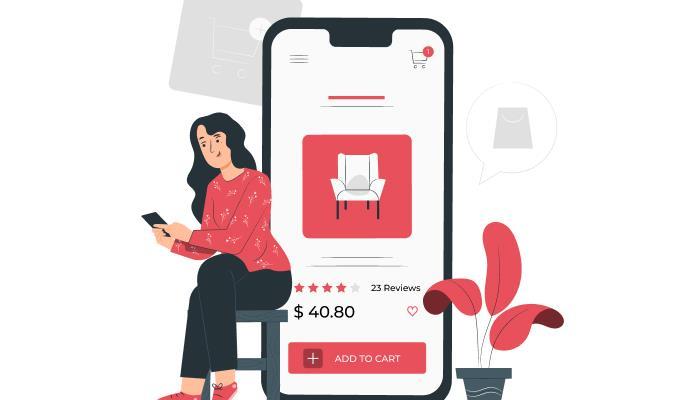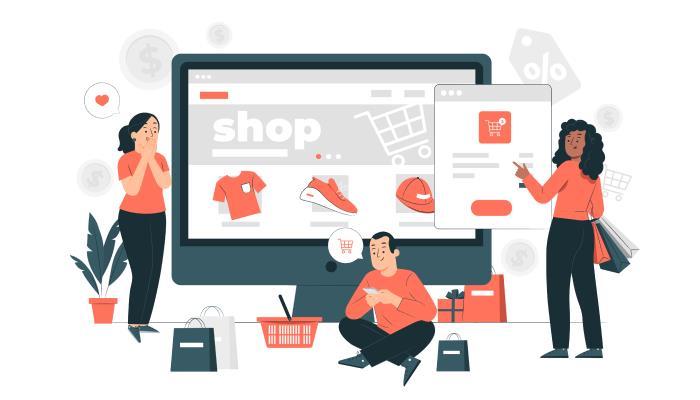“How to sell products online?”
The ultimate guide
E-commerce has become the easiest way for small businesses to sell products online. If you’re someone who’s thinking of how to sell products online. Then, you’re at the right place as here we’ll provide you with a step-by-step guide to selling products online. First, let’s look at some of the online selling statistics.

In 2021, an estimated 2.14 billion people worldwide purchased goods online.
About 50% of customers shop more on mobile than in-store.
Digital or mobile wallets are the preferred payment method of most online shoppers, used by 49%.
Nearly 80% of customers shop online at least once a month.
The significant surge in selling products online came after the pandemic hit. Even most of the businesses that have physical stores came online to get customers and boost revenue. Selling products online from home might
seem easy and simple but it is not. You need to do complete market research and find the best ways to go about it.
How to sell products online? To start with, you should evaluate what products you want to sell, who your potential customers are, and how you can reach out to them. You need to determine the ways to deliver your products to the customers easily at their doorstep. Comprehensive research and proper planning can help you put up a successful eCommerce strategy.
Keep reading the blog, to learn the step-by-step guide on how to sell products online. We are sure by the end, you’ll be able to create a plan to sell online.
How to sell products online?
Selling products online is a good way to expand your audience reach and increase sales. You can attract customers from different parts of the world and earn profits. Have a look at the steps to know how to sell products online.
1. Decide which products you want to sell

To begin selling online, you should decide which products you want to sell to the customers. You need to think about from where you’ll source the products to sell online. There are three ways from which online sellers source products: DIY (Do it yourself), wholesale, and dropshipping. No matter which method you use but each of them has its advantages and disadvantages. Whenever you are thinking of selling products online, select the products that you think are better than the products already available in the market. Now, we will discuss the three methods by which you can know how to create a product to sell online.
DIY products
This includes the products that you can make yourself. Some people do it as a hobby and some do it as a business. For example, scented candles, natural face masks, etc. DIY products require time and effort to be produced. But you can get maximum margin in this type of products.
For premium and expensive handcrafted products, you can take charges accordingly. However, you might need to reassess your process in case you don’t get enough orders to sustain your business.
Wholesale products
This is the traditional retail model in which you need to buy products in bulk from a manufacturer or wholesaler and sell them individually. There are various sites from where you can get wholesale items like Alibaba and Etsy Wholesale. However, make sure that you check the source carefully before placing your order.
You can read reviews, see Better Business Bureau (BBB) listings, and ask questions to the wholesalers. Ensure the products you buy are of high quality and match the specifications they have claimed. Since you have to sell the products to consumers online, you should look for good quality products.
Drop shipped products
This drop shipping model requires you to market the product and take orders. However, the order fulfillment is done by the supplier. Here, you get a low-profit
margin and also tough competition from other online sellers selling the same products. Some of the popular drop-shipping suppliers include AliExperss, Wholesale2B, Inventory Source, and Megagoods.
2. Identify your niche market
As you know the market is large and highly competitive. It’s always a good idea to find niche products that have specific target customers. Most of the time these are unique and one-of-a-kind products made in small batches. For example, lefthanded scissors are an example of a niche product.
You should first identify your niche market so that you can target those customers effectively. Select the niche market that you have knowledge about so as to enter that market easily. You can gather information about a niche by joining social media groups and communities related to it.
Watch sites like Trendwatching and Trend Hunter to know what are the latest trends in how to sell products online. From the Google Ads Keyword Planner tools, you can check how big is your niche market. All this information about your niche market will help you in planning your marketing strategy.

3. Do market research

Now, you know what you want to sell and who you want to sell. But will people be willing to buy what you’re selling? For this, you need to conduct market research and find out what value you offer and the suitable price for it. You need to find out answers to the following questions about how to sell a product online:
How big is the market for the products you want to sell?
Are people satisfied with the existing similar products in the market?
What needs and wants are those products not able to meet?
Which features do people want the most?
What is the selling price of your competitors’ products?
What are your prospective customers’ pain points?
Identify and study your competitors
Identify your competitors and find answers to the questions given below to know how to sell products online effectively.
What are the features of their product?
What’s their unique selling point?
At what range they have priced their product?
What are the marketing channels and strategies they’re using?
What are the features they’re lacking?
What revenue they’re generating?
What has helped them to sustain their brand in the market?
Ask questions to your target customers
You can conduct surveys to know if your product is appropriate and will be chosen by your prospective customers. Ask questions to your target customers and see what they think about your product idea. You can post about it on social groups and get opinions from people.
Take in-person interviews and see how people react to your product idea. Another easiest way is to ask questions through online surveys. You can ask prospects the right questions and gather relevant information. WebMaxy Analyzer can help you conduct market research surveys with ready-tolaunch templates.
Choose an appropriate price for your product
Pricing your products at a price lower than your competitors won’t work always. Nowadays, people are willing to pay a good price for high-quality products. However, if your competitors’ products are overpriced then you can put your products in a low price range.
Creating customer profiles and buyer personas will help you understand who exactly is your target customers. This way you’ll clearly be able to think about how to sell products online to those customers. You can create buyer personas based on different details like age group, gender, income, profession, interests, and hobbies.
Once, you have created different buyer personas, you can think about their needs, wants, pain points, and expectations. This information will help you to figure out how you can target distinct types of customers through personalized marketing.

5. Create your brand identity
To establish your business in the market, you need to create a brand identity. A brand identity is built with its logo, colors, website, and marketing. It helps a business to stand out from other businesses in the market. By creating a brand you can attract new customers and build a customer base.
4. Create customer profiles or buyer personasBrand name
For creating your brand identity, you should think of the brand name that best suits your product. You don’t always need to choose fancy or difficult words. Your brand name can be simple that convey the values or purpose of your product. Try to choose a unique brand name so that your customers don’t confuse it with any other brand.
Brand logo
A brand logo is the visual identity of a business that gives it a consistent look. For your brand logo, you can select the initials of your brand name or a small graphical design. You should select your brand colors based on your brand idea. For example, if you make eco-friendly products then you can opt for green color.
The colors you use for your brand logo are the first impression of your brand. Try to choose brand colors that are eye-catchy and entice customers to know more about you. There are certain colors that are often associated with specific cultures or emotions. Select one main color and two or three secondary colors for your brand logo and marketing.
Make sure that your brand logo is simple and easy to replicate as the brand logo will be used in marketing and prints. Complicated brand logos are not only difficult to reproduce but to comprehend as well. For creating your brand logo, you can use applications like Canva. This way you won’t need a graphic designer and you’ll be able to create your brand logo on your own.
Be careful while choosing images for your website, marketing, advertising, and social media. As the images you use would be associated with your brand image. For example, you’re selling a luxury dinner set. Then, you can portray your product on the dinner table or fine dining restaurant. This way people would associate your dinner set as an item to be used at the dinner table or a restaurant.
Brand voice
When you are communicating with your target market through social media or personal messaging, be careful with the selection of words. The way you
communicate with your customers can make or break your brand image. While writing your marketing copy, keep your customer profiles and buyer personas in mind. Think about who you are communicating with and what are their pain points or concerns.
Be consistent with your messaging, tone, and brand voice through different marketing channels like social media, email marketing, and advertising. Keep a consistent brand messaging and voice to help people associate it with your brand across distinct channels. You can also create a list of words that you would use in advertising copy often.
Want to enhance your customer experience?
Switch to an all-in-one eCommerce management platform, Webmaxy eGrowth.
Learn More!
6. Create your eCommerce website

How to sell a product online? To sell products online you should start by creating an eCommerce website. Add your brand logo and colors to the website to have consistency across multiple marketing channels. Ensure that your website is simple so that shoppers can easily find the products they want. Try to upload high-quality images with detailed descriptions so that customers know what they’re buying. Make sure your CTA buttons are visible and the buying process is easy for customers to understand. You can also try selling through landing pages. The landing pages are a good option if you want to sell a specific product or run promotions.
7. Set up different processes like payment and shipping
To start selling online, it’s important that you set up different processes like payment and shipping. You should try to provide free shipping especially if you’re starting up your online business. However, you can put the cost of boxing and packaging in the product pricing.
Set up customer relationship management software so that you get complete customer information when they purchase from you. Send shipping and delivery details to the customers via notifications to constantly keep in touch. Make sure to send offer and coupon emails to drive repeat purchases.
8. Create good product content
To attract customers and build their trust, it’s vital you provide what you claim. Your product content should include two important things: images and detailed descriptions.
Images: You should try to add high-resolution product images on your website. If the product looks attractive, there are high chance of people purchasing it. You can also ask your product supplier to provide you with professional images of the product. You can crop the images and add your own logo while adding them to your website.
Product descriptions: Keep your product descriptions brief with the necessary information. Use descriptive language and tell about product features. Give people reward points for adding customer reviews and testimonials.
9. Market and promote your products
Once you have built your website, and set up the different processes like payment & shipping, it’s time to market it. You can put up your brand and reach potential customers through various marketing channels. You can use social media like Facebook, Instagram, and YouTube to reach your customers. To reach customers quickly, you can use paid ads and add filters in accordance with your target audience.
These days people trust influencers more than brands for the review of different products. You can use influencer marketing to bring customers to your brand. You can also join different social media groups with your target audience to create awareness about your brand. Try adding product demo videos on YouTube to showcase your products.
You can ask people to join your email lists and subscribe to your newsletters. Send them offers and coupons to entice them to make purchases. You can use Google ads to bring back the customers who left their journey mid-way.
10. Modify your marketing strategy as and when required
After seeing all this information on how to sell a product online, you must be thinking it’s difficult. The best way to sell online is by creating a brand identity, setting up an eCommerce store, and targeting customers with an effective marketing strategy. However, all the efforts that you put into marketing your product won’t be enough always. You need to constantly look for new ways and latest trends to expand your reach.
WebMaxy eGrowth can help you manage your eCommerce platform effectively. This tool comes with a KPI dashboard that helps you measure various business metrics. The marketing insights feature can provide you with information about your distinct marketing channels’ performance. You can manage your different social media accounts in one place. Additionally, it has many features like audience segmentation, email marketing, marketing automation, Whatsapp marketing, customer loyalty, help desk, and retargeting.






